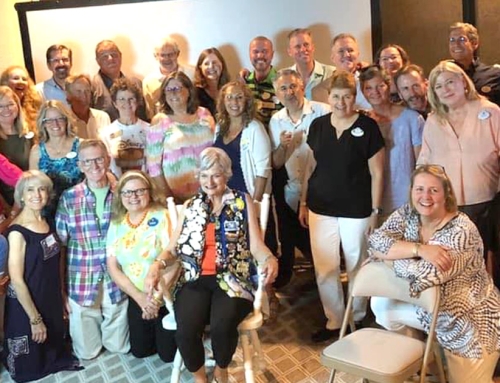I believe the most dangerous phrase in any language — the one that will absolutely derail any plans to improve the patient experience — is this one:
Because we’ve always done it that way.
We often don’t realize we’re saying and doing the same things over and over again out of habit rather than from a place of intention. When we slip into this default mode we become detached from the task at hand. Our motions and our words become almost robotic, lacking in any kind of personal or human touch.
I remember leading a training workshop on service recovery a few years back. I asked one attendee to describe how he and his team handle customer or patient complaints. He told me verbatim what they did. When I asked him if he could explain why they said and did those specific things, without missing a beat, he replied with a smile, I don’t know. We’ve just always done it that way.
Scripts Can Make Us Sound Like Robots
Too often, we rely on scripts to guide employees on what to say and do in certain situations. And while scripts are helpful, they aren’t very warm and fuzzy. They aren’t very “human.” In fact, they can become a sort of crutch we unintentionally lean on to give the false impression that we’re connecting with others when really we’re just going through the motions. Like a robot.
People can see right through auto-responses. I remember a few years ago I was in the check out line at a grocery store and as the clerk scanned each of my items, she asked me (without making eye contact or breaking her momentum), “Hi, did you find everything you need?” The truth is, I didn’t. And, as I started to explain to her that I wasn’t able to find everything I needed, she stopped and looked at me. She was caught off guard. She had no idea what to do with my response because she wasn’t prepared for any other answer than “Yes.” She wasn’t in the moment — she was just focused on reciting the words she was told to say to each person checking out.
We have to stop this kind of auto response mechanism, this default language, and become more aware, more intentional, with the words we use. Auto responses can come across as insincere, but when we intentionally choose a language of kindness that is patient-centric or customer-centric, the interaction is more sincere and authentic (and just plain nicer for everyone involved.)
Choosing a Language of Kindness
HOW we say something is just as important as what we say. Maybe even more important.
 The words we use to communicate with others matter. They hold a lot of power. They can offend or uplift; inspire or condemn; reassure or unsettle.
The words we use to communicate with others matter. They hold a lot of power. They can offend or uplift; inspire or condemn; reassure or unsettle.
Sometimes expediency is needed. A fire or other urgent situation, of course, requires fewer words, more action and quite frankly, less “politeness”. For instance: Fire! Earthquake! Evacuate now! Take cover! But in general, we live in the non-emergency space, which means there is no reason we can’t be both efficient AND kind.
Choosing a language of kindness can change the tone of the message and help humanize the experience. Consider how each of these phrases might make a customer or patient feel. Each has the same goal, but the approach is slightly different. The first is all business. The second is more “human.”
Next in line! vs May I help the next person in line please?
What do you need? vs How may I be of service?
No littering! vs Thank you for keeping this area clean by using the trash receptacles.
I don’t know vs. I’m not sure, but I’ll be happy to find out for you.
Choosing a language of kindness takes a little bit of effort at first, but it’s a critical part of improving the experience for patients, customers, and employees. If you want to change your culture, you must first change your stories. If you want to change your stories, you must first change your words, specifically, changing your words so that they’re more patient-centric (or customer-centric). This is what we mean by choosing a language of kindness.
Less Robot, More Human
One physician we worked with told us that he decided to stop apologizing to patients for their wait. It was something he and his team had always done but he realized he needed to change his approach. Why? Because he found that it begged more information and it dragged the conversation out longer than necessary. He would begin his appointments by apologizing for the wait which made his patients ask for an explanation and then wonder why they had to wait and they went round and round with no resolution.
Instead, the physician changed up his language to focus more on the individual patient. By choosing a language of kindness that was more patient-centered, he found it created a better experience for him and his patients. Now, he begins any late appointments by acknowledging the lateness and saying, “Thank you for waiting. I know your time is valuable and I appreciate you waiting. Now, tell me how you’ve been feeling…” By shifting his language choice slightly, the conversation pivoted away from the reasons why the exam was running late and instead focused on acknowledging the wait and thanking the patient. With this out of the way, the patient’s feelings were addressed and validated and the physician was free to move on and conduct the clinical exam.
There is an art and science in medicine and healthcare. The science is the WHAT (clinical expertise, efficiency). The art is the HOW – how the clinical care is delivered (with kindness, courtesy, compassion). When we get trapped into doing things because we’ve always done them that way, we lose authenticity, sincerity. But when we choose a language of kindness, and embrace the art and science of healthcare, we become focused on on elevating the human side of healthcare and creating better experiences for patient and employees.
******
Elevating the human side of healthcare is exactly what my team and I do. Want to find out more? Drop me a line in the comments here, send me an email at jake.poore@wecreateloyalty.com, or call 407.859.2826 to speak to any of our team members.






Leave A Comment